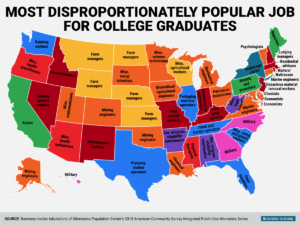For most Americans their homes represent their single largest investment, but times are changing especially for college grads. The new challenger is a bachelors degree. The costs to attend college consistently outpace inflation. Other than healthcare, education costs are rising faster than those in any other sector of the economy. Only thirty years ago $15K covered tuition, room & board, books, and a generous supply of the local brew. Today that same $15K gets the middle two, but scarcely scratches the surface of tuition. Tuition at the most expensive schools tops $50K. When you add room & board and books the cost can exceed $70K per year. Throw in the aforementioned escalating costs and four years at an expensive private school could easily top $300K.
What about state schools? Here there’s mixed news. Thanks to the local taxpayers tuition is generally much lower, especially for in-state students. In-state tuition ranges from a low of $5K in Wyoming to $15.7K in New Hampshire with an average $9,650. While not as generous, most states extend some help to out-of-state students, too. At almost $37K Vermont charges the most to visiting students, while South Dakota’s rate of $11K is the lowest. The average out-of-state tuition is just under $25K. Other expenses such as room & board and books are similar to private universities. That leads to total in-state costs in the $80-125K range depending on your home state. If you’re an out-of-state student four years could set you back a little more than $200K.
To be fair very few students pay full freight at most of these schools. In addition to financial aid there are merit scholarships, work-study programs, co-ops, and other opportunities to fund college. For the average student that includes loans. Currently 44.2M Americans owe $1.41T. That’s $600B more than Americans owe on credit cards. The average 2016 college grad owes $37K and will face payments above $350/month. Roughly one in nine graduates under 30 is more than 90 days behind in making their loan payments. Lawyers and doctors, enter the workforce with average debts of $141K and $162K respectively.
What’s driving college grads to march into the abyss of debt like lemmings? The altruists among you might suggest a quest for knowledge or a desire to discover themselves. I’ll grant those may be contributing factors, but if you ask most college grads why they’re taking on so much debt they’ll answer – jobs. They might say something about career paths or graduate school, but ultimately it’s about jobs. Dr. Smith (the economics professor at UNC, not the whacko from Lost in Space), was fond of saying the ROI for a college education was 15%. He was talking about the return to students. While figures I’ve seen still point to positive ROIs for a four-year degree, the percentages are down and the required entry capital is up. Obviously, the universities were listening, too and they’re taking their share of the pie.
So if the answer is jobs. What jobs are college grads taking? The answer of course is this week’s Map Monday feature courtesy of Business Insiders. To be clear, these are the disproportionately popular jobs with grads in each state.

As always thanks for reading.
Armen

